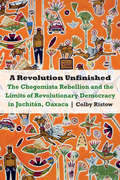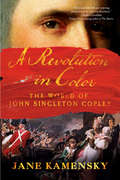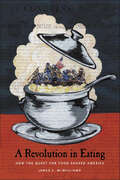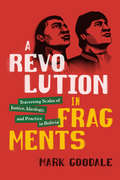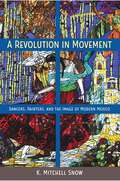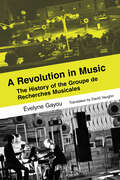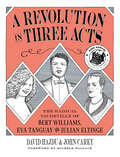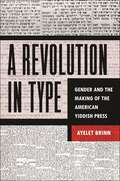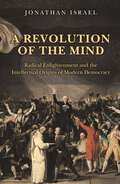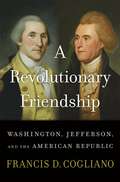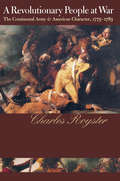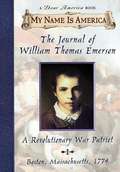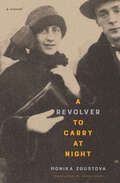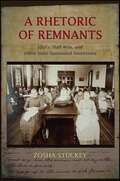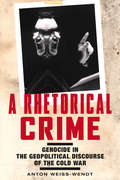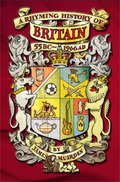- Table View
- List View
A Revolution Of Their Own
by Anastasia Posadskaya-Vanderbeck Barbara EngelThe stories of these eight Russian women offer an extremely rare perspective into personal life in the Soviet era. Some were from the poor peasantry and working class, groups in whose name the revolution was carried out and who sometimes gained unprecedented opportunities after the revolution. Others, born to "misfortune" as the daughters of nobles, parish priests, or those peasants termed well-to-do, suffered bitterly as enemies to a new government. The women interviewed here speak candidly about family life, work, sexual relations, marriage and divorce, childbirth and childbearing, and legalized abortion and the underground pursuit of such services after abortion was outlawed in 1936.As no previous book has done, A Revolution of Their Own illuminates the harsh reality of women's daily lives in the Soviet Union as well as reveals the accomplishments made possible by the expanded opportunities that the new Soviet government provided for women. Their stories show why many Russian women continue to take pride in the public achievements of the Soviet period despite, or perhaps because of, the painful price each was made to pay.
A Revolution Of Their Own
by Anastasia Posadskaya-Vanderbeck Barbara EngelThe stories of these eight Russian women offer an extremely rare perspective into personal life in the Soviet era. Some were from the poor peasantry and working class, groups in whose name the revolution was carried out and who sometimes gained unprecedented opportunities after the revolution. Others, born to "misfortune" as the daughters of nobles, parish priests, or those peasants termed well-to-do, suffered bitterly as enemies to a new government. The women interviewed here speak candidly about family life, work, sexual relations, marriage and divorce, childbirth and childbearing, and legalized abortion and the underground pursuit of such services after abortion was outlawed in 1936.As no previous book has done, A Revolution of Their Own illuminates the harsh reality of women's daily lives in the Soviet Union as well as reveals the accomplishments made possible by the expanded opportunities that the new Soviet government provided for women. Their stories show why many Russian women continue to take pride in the public achievements of the Soviet period despite, or perhaps because of, the painful price each was made to pay.
A Revolution Unfinished: The Chegomista Rebellion and the Limits of Revolutionary Democracy in Juchitán, Oaxaca (The Mexican Experience)
by Colby RistowIn October 1911 the governor of Oaxaca, Mexico, ordered a detachment of approximately 250 soldiers to take control of the town of Juchitán from Jose F. “Che” Gomez and a movement defending the principle of popular sovereignty. The standoff between federal soldiers and the Chegomistas continued until federal reinforcements arrived and violently repressed the movement in the name of democracy. In A Revolution Unfinished Colby Ristow provides the first book-length study of what has come to be known as the Chegomista Rebellion, shedding new light on a conflict previously lost in the shadows of the concurrent Zapatista uprising. The study examines the limits of democracy under Mexico’s first revolutionary regime through a detailed analysis of the confrontation between Mexico’s nineteenth-century tradition of moderate liberalism and locally constructed popular liberalism in the politics of Juchitán, Oaxaca. Couched in the context of local, state, and national politics at the beginning of the revolution, the study draws on an array of local, national, and international archival and newspaper sources to provide a dramatic day-by-day description of the Chegomista Rebellion and the events preceding it. Ristow links the events in Juchitán with historical themes such as popular politics, ethnicity, and revolutionary state formation and strips away the romanticism of previous studies of Juchitán, offering a window into the mechanics of late Porfirian state-society relations and early revolutionary governance.
A Revolution for Our Rights: Indigenous Struggles for Land and Justice In Bolivia, 1880-1952
by Laura GotkowitzA Revolution for Our Rights is a critical reassessment of the causes and significance of the Bolivian Revolution of 1952. Historians have tended to view the revolution as the result of class-based movements that accompanied the rise of peasant leagues, mineworker unions, and reformist political projects in the 1930s. Laura Gotkowitz argues that the revolution had deeper roots in the indigenous struggles for land and justice that swept through Bolivia during the first half of the twentieth century. Challenging conventional wisdom, she demonstrates that rural indigenous activists fundamentally reshaped the military populist projects of the 1930s and 1940s. In so doing, she chronicles a hidden rural revolution--before the revolution of 1952--that fused appeals for equality with demands for a radical reconfiguration of political power, landholding, and rights. Gotkowitz combines an emphasis on national political debates and congresses with a sharply focused analysis of Indian communities and large estates in the department of Cochabamba. The fragmented nature of Cochabamba's Indian communities and the pioneering significance of its peasant unions make it a propitious vantage point for exploring contests over competing visions of the nation, justice, and rights. Scrutinizing state authorities' efforts to impose the law in what was considered a lawless countryside, Gotkowitz shows how, time and again, indigenous activists shrewdly exploited the ambiguous status of the state's pro-Indian laws to press their demands for land and justice. Bolivian indigenous and social movements have captured worldwide attention during the past several years. By describing indigenous mobilization in the decades preceding the revolution of 1952, A Revolution for Our Rights illuminates a crucial chapter in the long history behind present-day struggles in Bolivia and contributes to an understanding of indigenous politics in modern Latin America more broadly.
A Revolution in Color: The World of John Singleton Copley
by Jane KamenskyThis bold new history recovers an unknown American Revolution as seen through the eyes of Boston-born painter John Singleton Copley. Boston in the 1740s: a bustling port at the edge of the British empire. A boy comes of age in a small wooden house along the Long Wharf, which juts into the harbor, as though reaching for London thousands of miles across the ocean. Sometime in his childhood, he learns to draw. That boy was John Singleton Copley, who became, by the 1760s, colonial America's premier painter. His brush captured the faces of his neighbors--ordinary men like Paul Revere, John Hancock, and Samuel Adams--who would become the revolutionary heroes of a new United States. Today, in museums across America, Copley's brilliant portraits evoke patriotic fervor and rebellious optimism. The artist, however, did not share his subjects' politics. Copley's nation was Britain; his capital, London. When rebellion sundered Britain's empire, both kin and calling determined the painter's allegiances. He sought the largest canvas for his talents and the safest home for his family. So, by the time the United States declared its independence, Copley and his kin were in London. He painted America's revolution from a far shore, as Britain's American War. An intimate portrait of the artist and his extraordinary times, Jane Kamensky's A Revolution in Color masterfully reveals the world of the American Revolution, a place in time riven by divided loyalties and tangled sympathies. Much like the world in which he lived, Copley's life and career were marked by spectacular rises and devastating falls. But though his ambivalence cost him dearly, the painter's achievements in both Britain and America made him a towering figure of both nations' artistic legacies.
A Revolution in Eating: How the Quest for Food Shaped America (Arts and Traditions of the Table Perspectives on Culinary History)
by James E. McWilliamsA colorful, spirited tour of culinary attitudes, tastes, and techniques throughout colonial America. Confronted by unfamiliar animals, plants, and landscapes, settlers in the colonies and West Indies found new ways to produce food. Integrating their British and European tastes with the demands and bounty of the rugged American environment, early Americans developed a range of regional cuisines. From the kitchen tables of typical Puritan families to Iroquois longhouses in the backcountry and slave kitchens on southern plantations, McWilliams portrays the grand variety and inventiveness that characterized colonial cuisine. As colonial America grew, so did its palate, as interactions among European settlers, Native Americans, and African slaves created new dishes and attitudes about food. McWilliams considers how Indian corn, once thought by the colonists as &“fit for swine,&” became a fixture in the colonial diet. He also examines the ways in which African slaves influenced West Indian and American southern cuisine. While a mania for all things British was a unifying feature of eighteenth-century cuisine, the colonies discovered a national beverage in domestically brewed beer, which came to symbolize solidarity and loyalty to the patriotic cause in the Revolutionary era. The beer and alcohol industry also instigated unprecedented trade among the colonies and further integrated colonial habits and tastes. Victory in the American Revolution initiated a &“culinary declaration of independence,&” prompting the antimonarchical habits of simplicity, frugality, and frontier ruggedness to define the cuisine of the United States—a shift that imbued values that continue to shape the nation&’s attitudes to this day. &“A lively and informative read.&” —TheNew Yorker
A Revolution in Eating: How the Quest for Food Shaped America (Arts and Traditions of the Table: Perspectives on Culinary History)
by James McWilliamsSugar, pork, beer, corn, cider, scrapple, and hoppin' John all became staples in the diet of colonial America. The ways Americans cultivated and prepared food and the values they attributed to it played an important role in shaping the identity of the newborn nation. In A Revolution in Eating, James E. McWilliams presents a colorful and spirited tour of culinary attitudes, tastes, and techniques throughout colonial America. Confronted by strange new animals, plants, and landscapes, settlers in the colonies and West Indies found new ways to produce food. Integrating their British and European tastes with the demands and bounty of the rugged American environment, early Americans developed a range of regional cuisines. From the kitchen tables of typical Puritan families to Iroquois longhouses in the backcountry and slave kitchens on southern plantations, McWilliams portrays the grand variety and inventiveness that characterized colonial cuisine. As colonial America grew, so did its palate, as interactions among European settlers, Native Americans, and African slaves created new dishes and attitudes about food. McWilliams considers how Indian corn, once thought by the colonists as "fit for swine," became a fixture in the colonial diet. He also examines the ways in which African slaves influenced West Indian and American southern cuisine. While a mania for all things British was a unifying feature of eighteenth-century cuisine, the colonies discovered a national beverage in domestically brewed beer, which came to symbolize solidarity and loyalty to the patriotic cause in the Revolutionary era. The beer and alcohol industry also instigated unprecedented trade among the colonies and further integrated colonial habits and tastes. Victory in the American Revolution initiated a "culinary declaration of independence," prompting the antimonarchical habits of simplicity, frugality, and frontier ruggedness to define American cuisine. McWilliams demonstrates that this was a shift not so much in new ingredients or cooking methods, as in the way Americans imbued food and cuisine with values that continue to shape American attitudes to this day.
A Revolution in Fragments: Traversing Scales of Justice, Ideology, and Practice in Bolivia
by Mark GoodaleThe years between 2006 and 2015, during which Evo Morales became Bolivia's first indigenous president, have been described as a time of democratic and cultural revolution, world renewal (Pachakuti), reconstituted neoliberalism, or simply &“the process of change.&” In A Revolution in Fragments Mark Goodale unpacks these various analytical and ideological frameworks to reveal the fragmentary and contested nature of Bolivia's radical experiments in pluralism, ethnic politics, and socioeconomic planning. Privileging the voices of social movement leaders, students, indigenous intellectuals, women's rights activists, and many others, Goodale uses contemporary Bolivia as an ideal case study with which to theorize the role that political agency, identity, and economic equality play within movements for justice and structural change.
A Revolution in Movement: Dancers, Painters, and the Image of Modern Mexico (Dancers, Painters, and the Image of Modern Mexico)
by K. Mitchell SnowHonorable Mention, Latin American Studies Association Mexico Section Best Book in the HumanitiesHow collaborations between dancers and painters shaped cultural identity in MexicoA Revolution in Movement is the first book to illuminate how collaborations between dancers and painters shaped Mexico’s postrevolutionary cultural identity. K. Mitchell Snow traces this relationship throughout nearly half a century of developments in Mexican dance—the emulation of Diaghilev’s Ballets Russes in the 1920s, the adoption of U.S.-style modern dance in the 1940s, and the creation of ballet-inspired folk dance in the 1960s.Snow describes the appearances in Mexico by Russian ballerina Anna Pavlova and Spanish concert dancer Tortóla Valencia, who helped motivate Mexico to express its own national identity through dance. He discusses the work of muralists and other visual artists in tandem with Mexico’s theatrical dance world, including Diego Rivera’s collaborations with ballet composer Carlos Chávez; Carlos Mérida’s leadership of the National School of Dance; José Clemente Orozco’s involvement in the creation of the Ballet de la Ciudad de México; and Miguel Covarrubias, who led the "golden age" of Mexican modern dance. Snow draws from a rich trove of historical newspaper accounts and other contemporary documents to show how these collaborations produced an image of modern Mexico that would prove popular both locally and internationally and continues to endure today.
A Revolution in Music: The History of the Groupe de Recherches Musicales
by Évelyne GayouEstablished in the 1950s by musician and engineer Pierre Schaeffer, the Groupe de Recherches Musicales would become the nerve center for avant-garde artists experimenting with sound and acoustics, as well as the birthplace of a genre of music-making enabled by new recording technologies and sound pioneers: musique concrète. Évelyne Gayou—herself a researcher, composer, and producer at the GRM—tells the history of the storied institution through the people, works, technologies, and research developed there. Placing musique concrète within a broad historical context extending from the early twentieth-century avant-garde's experiments with noise to the development of techniques in sound recording (at the Studio d'Essai in the 1940s) and later in sound synthesis, Gayou shows how recording technology made it possible for composers to not only create music from sounds in the world around them but also create acousmatic music—novel sounds without a visible connection to their source. Available in English translation for the first time, this updated edition will be an important resource for readers interested in the pioneering works and techniques of Schaeffer and his contemporaries, as well as their influence on the makers of new music and the contemporary avant-garde.
A Revolution in Three Acts: The Radical Vaudeville of Bert Williams, Eva Tanguay, and Julian Eltinge
by David Hajdu John CareyBert Williams—a Black man forced to perform in blackface who challenged the stereotypes of minstrelsy. Eva Tanguay—an entertainer with the signature song “I Don’t Care” who flouted the rules of propriety to redefine womanhood for the modern age. Julian Eltinge—a female impersonator who entranced and unnerved audiences by embodying the feminine ideal Tanguay rejected. At the turn of the twentieth century, they became three of the most provocative and popular performers in vaudeville, the form in which American mass entertainment first took shape.A Revolution in Three Acts explores how these vaudeville stars defied the standards of their time to change how their audiences thought about what it meant to be American, to be Black, to be a woman or a man. The writer David Hajdu and the artist John Carey collaborate in this work of graphic nonfiction, crafting powerful portrayals of Williams, Tanguay, and Eltinge to show how they transformed American culture. Hand-drawn images give vivid visual form to the lives and work of the book’s subjects and their world.This book is at once a deft telling of three intricately entwined stories, a lush evocation of a performance milieu with unabashed entertainment value, and an eye-opening account of a key moment in American cultural history with striking parallels to present-day questions of race, gender, and sexual identity.
A Revolution in Type: Gender and the Making of the American Yiddish Press
by Ayelet Brinn73rd National Jewish Book Awards FinalistA fascinating glimpse into the complex and often unexpected ways that women and ideas about women shaped widely read Jewish newspapersBetween the 1880s and 1920s, Yiddish-language newspapers rose from obscurity to become successful institutions integral to American Jewish life. During this period, Yiddish-speaking immigrants came to view newspapers as indispensable parts of their daily lives. For many Jewish immigrants from Eastern Europe, acclimating to America became inextricably intertwined with becoming a devoted reader of the Yiddish periodical press, as the newspapers and their staffs became a fusion of friends, religious and political authorities, tour guides, matchmakers, and social welfare agencies.In A Revolution in Type, Ayelet Brinn argues that women were central to the emergence of the Yiddish press as a powerful, influential force in American Jewish culture. Through rhetorical debates about women readers and writers, the producers of the Yiddish press explored how to transform their newspapers to reach a large, diverse audience. The seemingly peripheral status of women’s columns and other newspaper features supposedly aimed at a female audience—but in reality, read with great interest by male and female readers alike—meant that editors and publishers often used these articles as testing grounds for the types of content their newspapers should encompass. The book explores the discovery of previously unknown work by female writers in the Yiddish press, whose contributions most often appeared without attribution; it also examines the work of men who wrote under women’s names in order to break into the press. Brinn shows that instead of framing issues of gender as marginal, we must view them as central to understanding how the American Yiddish press developed into the influential, complex, and diverse publication field it eventually became.
A Revolution of Their Own: Voices of Women in Soviet History
by Barbara Alpern Engel Anastasia Posadskaya-VanderbeckThe stories of these eight Russian women offer an extremely rare perspective into personal life in the Soviet era. Some were from the poor peasantry and working class, groups in whose name the revolution was carried out and who sometimes gained unprecedented opportunities after the revolution. Others, born to “misfortune” as the daughters of nobles, parish priests, or those peasants termed well-to-do, suffered bitterly as enemies to a new government. The women interviewed here speak candidly about family life, work, sexual relations, marriage and divorce, childbirth and childbearing, and legalized abortion and the underground pursuit of such services after abortion was outlawed in 1936.As no previous book has done, A Revolution of Their Own illuminates the harsh reality of women’s daily lives in the Soviet Union as well as reveals the accomplishments made possible by the expanded opportunities that the new Soviet government provided for women. Their stories show why many Russian women continue to take pride in the public achievements of the Soviet period despite, or perhaps because of, the painful price each was made to pay.
A Revolution of the Mind: Radical Enlightenment and the Intellectual Origins of Modern Democracy
by Jonathan IsraelA leading historian reveals the radical origins of humanity's most cherished secular valuesDemocracy, free thought and expression, religious tolerance, individual liberty, political self-determination of peoples, sexual and racial equality—these values have firmly entered the mainstream in the decades since they were enshrined in the 1948 U.N. Declaration of Human Rights. But if these ideals no longer seem radical today, their origin was very radical indeed—far more so than most historians have been willing to recognize. In A Revolution of the Mind, Jonathan Israel, one of the world's leading historians of the Enlightenment, traces the philosophical roots of these ideas to what were the least respectable strata of Enlightenment thought—what he calls the Radical Enlightenment.Originating as a clandestine movement of ideas that was almost entirely hidden from public view during its earliest phase, the Radical Enlightenment matured in opposition to the moderate mainstream Enlightenment dominant in Europe and America in the eighteenth century. During the revolutionary decades of the 1770s, 1780s, and 1790s, the Radical Enlightenment burst into the open, only to provoke a long and bitter backlash. A Revolution of the Mind shows that this vigorous opposition was mainly due to the powerful impulses in society to defend the principles of monarchy, aristocracy, empire, and racial hierarchy—principles linked to the upholding of censorship, church authority, social inequality, racial segregation, religious discrimination, and far-reaching privilege for ruling groups.In telling this fascinating history, A Revolution of the Mind reveals the surprising origin of our most cherished values—and helps explain why in certain circles they are frequently disapproved of and attacked even today.
A Revolutionary Friendship: Washington, Jefferson, and the American Republic
by Francis D. CoglianoThe first full account of the relationship between George Washington and Thomas Jefferson, countering the legend of their enmity while drawing vital historical lessons from the differences that arose between them.Martha Washington’s worst memory was the death of her husband. Her second worst was Thomas Jefferson’s awkward visit to pay his respects subsequently. Indeed, by the time George Washington had died in 1799, the two founders were estranged. But that estrangement has obscured the fact that for most of their thirty-year acquaintance they enjoyed a productive relationship. Precisely because they shared so much, their disagreements have something important to teach us.In constitutional design, for instance: Whereas Washington believed in the rule of traditional elites like the Virginia gentry, Jefferson preferred what we would call a meritocratic approach, by which elites would be elected on the basis of education and skills. And while Washington emphasized a need for strong central government, Jefferson favored diffusion of power across the states. Still, as Francis Cogliano argues, common convictions equally defined their relationship: a passion for American independence and republican government, as well as a commitment to westward expansion and the power of commerce. They also both evolved a skeptical view of slavery, eventually growing to question the institution, even as they took only limited steps to abolish it.What remains fascinating is that the differences between the two statesmen mirrored key political fissures of the early United States, as the unity of revolutionary zeal gave way to competing visions for the new nation. A Revolutionary Friendship brilliantly captures the dramatic, challenging, and poignant reality that there was no single founding ideal—only compromise between friends and sometime rivals.
A Revolutionary People At War
by Charles RoysterIn this highly acclaimed book, Charles Royster explores the mental processes and emotional crises that Americans faced in their first national war. He ranges imaginatively outside the traditional techniques of analytical historical exposition to build his portrait of how individuals and a populace at large faced the Revolution and its implications. The book was originally published by UNC Press in 1980.
A Revolutionary War Patriot: The Journal of William Thomas Emerson (My Name Is America)
by Barry DenenbergSet in Massachusetts, this is the story of a boy surrounded by the politics and violence of war, who becomes a spy for the rebel colonists.
A Revolver to Carry at Night: A Novel
by Monika ZgustovaA captivating, nuanced portrait of the life of Véra Nabokov, who dedicated herself to advancing her husband&’s writing career, playing a vital role in the creation of his greatest works.Véra Nabokov (1902–1991) was in many ways the epitome of the wife of a great man: keenly aware of her husband&’s extraordinary talent, she decided to make his success her ultimate goal, throughout fifty-two years of marriage until his death in 1977. The first reader of his texts, Véra worked as typist and editor. She organized their lives in exile, as they traveled to Berlin, Paris, Switzerland, and, most importantly, the US, where she convinced Vladimir to focus on writing novels in English. She not only controlled the family&’s finances and contract negotiations, but also attempted to control his friendships—particularly with women—going so far as to audit his classes.In this rich, sweeping novel, Monika Zgustova immerses us in the daily life of this remarkable couple, offering insights into their complex personal and professional relationships, as well as the real people behind characters such as Lolita. Véra considered herself an independent woman, but was she really, when her husband took up so much space? And without Véra, could Nabokov have become one of the twentieth century&’s greatest writers?
A Rhetoric of Aesthetic Power: Moving Forms (Rhetoric, Politics and Society)
by Christian KockThis book offers a theory of those formal properties of art that are apt to afford strong aesthetic experience – a project resembling Aristotle’s in the Poetics, where he analysed structures in tragedies that condition the “peculiar pleasure” of tragedy. However, the book’s scope cuts across all genres of literature and also includes classical music – the formal art par excellence. Drawing on a wide array of recent theoretical work and empirical evidence, the book closely analyses dozens of examples of both art forms. Besides Aristotle, major inspiration comes from two modern master thinkers: the linguist Roman Jakobson, who defined the “poetic function” of language, and the rhetorician Kenneth Burke, who proposed a “psychological” concept of form. Throughout, the book argues for aesthetic experience as an end in itself and a component of quality of life, one to which everyone should have access – rather than just a means to other ends.
A Rhetoric of Bourgeois Revolution: The Abbé Sieyes and What is the Third Estate?
by William H Sewell Jr.What Is the Third Estate? was the most influential pamphlet of 1789. It did much to set the French Revolution on a radically democratic course. It also launched its author, the Abbé Sieyes, on a remarkable political career that spanned the entire revolutionary decade. Sieyes both opened the revolution by authoring the National Assembly's declaration of sovereignty in June of 1789 and closed it in 1799 by engineering Napoleon Bonaparte's coup d'état.This book studies the powerful rhetoric of the great pamphlet and the brilliant but enigmatic thought of its author. William H. Sewell's insightful analysis reveals the fundamental role played by the new discourse of political economy in Sieyes's thought and uncovers the strategies by which this gifted rhetorician gained the assent of his intended readers--educated and prosperous bourgeois who felt excluded by the nobility in the hierarchical social order of the old regime. He also probes the contradictions and incoherencies of the pamphlet's highly polished text to reveal fissures that reach to the core of Sieyes's thought--and to the core of the revolutionary project itself.Combining techniques of intellectual history and literary analysis with a deep understanding of French social and political history, Sewell not only fashions an illuminating portrait of a crucial political document, but outlines a fresh perspective on the history of revolutionary political culture.
A Rhetoric of Remnants: Idiots, Half-Wits, and Other State-Sponsored Inventions
by Zosha StuckeyIn the nineteenth century, language, rather than biology, created what we think of as disability. Much of the rhetorical nature of "idiocy," and even intelligence itself, can be traced to the period when the New York State Asylum for Idiots in Syracuse first opened in 1854—memorialized today as the first public school for people considered "feeble-minded" or "idiotic." The asylum-school pupil is a monumental example of how education attempts to mold and rehabilitate one's being. Zosha Stuckey demonstrates how all education is in some way complicit in the urge to normalize.The broad, unstable, and cross-cultural category of "people with disabilities" endures an interesting relationship with rhetoric, education, speaking, and writing. Stuckey demystifies some of that relationship which requires new modes of inquiry and new ways of thinking, and she calls into question many of the assumptions about embodied differences as they relate to pedagogy, history, and public participation.
A Rhetorical Crime: Genocide in the Geopolitical Discourse of the Cold War (Genocide, Political Violence, Human Rights)
by Anton Weiss-Wendt Douglas Irvin-EricksonThe Genocide Convention was drafted by the United Nations in the late 1940s, as a response to the horrors of the Second World War. But was the Genocide Convention truly effective at achieving its humanitarian aims, or did it merely exacerbate the divisive rhetoric of Cold War geopolitics?A Rhetorical Crime shows how genocide morphed from a legal concept into a political discourse used in propaganda battles between the United States and the Soviet Union. Over the course of the Cold War era, nearly eighty countries were accused of genocide, and yet there were few real-time interventions to stop the atrocities committed by genocidal regimes like the Cambodian Khmer Rouge. Renowned genocide scholar Anton Weiss-Wendt employs a unique comparative approach, analyzing the statements of Soviet and American politicians, historians, and legal scholars in order to deduce why their moral posturing far exceeded their humanitarian action.
A Rhyming History of Britain
by James MuirdenThe Rhyming History of Britain Has never - heretofore - been written 'I am not a historian. In fact, I wrote this poem in order to teach myself some history. I thought that sorting facts into verse form would concentrate my mind wonderfully. Which it did.' Brought up with the iambic pentameters of Hilaire Belloc's Cautionary Verses ringing in his ears, James Muirden's rhyming history is a long poem in an equally simple and jolly form. Charmingly irreverent, magically humorous, delightfully illustrated by David Eccles - recently acclaimed for his line drawings for Now We Are Sixty - this is the perfect gift for historians and non-historians alike. This cheerful poem has been written To tell the History of Britain; For People puzzled by the Past - If this means YOU, here's help at last! From Celts to Churchill, it relates (With all the most Important Dates) Our country's convoluted course... Why Richard hollered for a horse; Why Eleanor was such a catch; Why no one liked the Spanish Match; The pros and cons of Laissez Faire; Smart Georgian ladies' underwear; Why Charles the Second went to plays; Why Queen Jane reigned for just nine days; The causes of the Irish trouble; The bursting of the South Sea Bubble; That giant glasshouse in Hyde Park; The First World War's igniting spark...
A Rhyming History of Britain
by James MuirdenThe Rhyming History of Britain Has never - heretofore - been written'I am not a historian. In fact, I wrote this poem in order to teach myself some history. I thought that sorting facts into verse form would concentrate my mind wonderfully. Which it did.' Brought up with the iambic pentameters of Hilaire Belloc's Cautionary Verses ringing in his ears, JamesMuirden's rhyming history is a long poem in an equally simple and jolly form. Charmingly irreverent, magically humorous, delightfully illustrated by David Eccles - recently acclaimed for his line drawings for Now We Are Sixty - this is the perfect gift for historians and non-historians alike.This cheerful poem has been writtenTo tell the History of Britain;For People puzzled by the Past -If this means YOU, here's help at last!From Celts to Churchill, it relates(With all the most Important Dates)Our country's convoluted course...Why Richard hollered for a horse;Why Eleanor was such a catch;Why no one liked the Spanish Match;The pros and cons of Laissez Faire;Smart Georgian ladies' underwear;Why Charles the Second went to plays;Why Queen Jane reigned for just nine days;The causes of the Irish trouble;The bursting of the South Sea Bubble;That giant glasshouse in Hyde Park;The First World War's igniting spark...
A Rich Brew: How Cafés Created Modern Jewish Culture
by Shachar M PinskerFinalist, 2018 National Jewish Book Award for Modern Jewish Thought and Experience, presented by the Jewish Book CouncilWinner, 2019 Jordan Schnitzer Book Award, in the Jewish Literature and Linguistics Category, given by the Association for Jewish StudiesA fascinating glimpse into the world of the coffeehouse and its role in shaping modern Jewish cultureUnlike the synagogue, the house of study, the community center, or the Jewish deli, the café is rarely considered a Jewish space. Yet, coffeehouses profoundly influenced the creation of modern Jewish culture from the mid-nineteenth to mid-twentieth centuries. With roots stemming from the Ottoman Empire, the coffeehouse and its drinks gained increasing popularity in Europe. The “otherness,” and the mix of the national and transnational characteristics of the coffeehouse perhaps explains why many of these cafés were owned by Jews, why Jews became their most devoted habitués, and how cafés acquired associations with Jewishness. Examining the convergence of cafés, their urban milieu, and Jewish creativity, Shachar M. Pinsker argues that cafés anchored a silk road of modern Jewish culture. He uncovers a network of interconnected cafés that were central to the modern Jewish experience in a time of migration and urbanization, from Odessa, Warsaw, Vienna, and Berlin to New York City and Tel Aviv. A Rich Brew explores the Jewish culture created in these social spaces, drawing on a vivid collection of newspaper articles, memoirs, archival documents, photographs, caricatures, and artwork, as well as stories, novels, and poems in many languages set in cafés. Pinsker shows how Jewish modernity was born in the café, nourished, and sent out into the world by way of print, politics, literature, art, and theater. What was experienced and created in the space of the coffeehouse touched thousands who read, saw, and imbibed a modern culture that redefined what it meant to be a Jew in the world.

